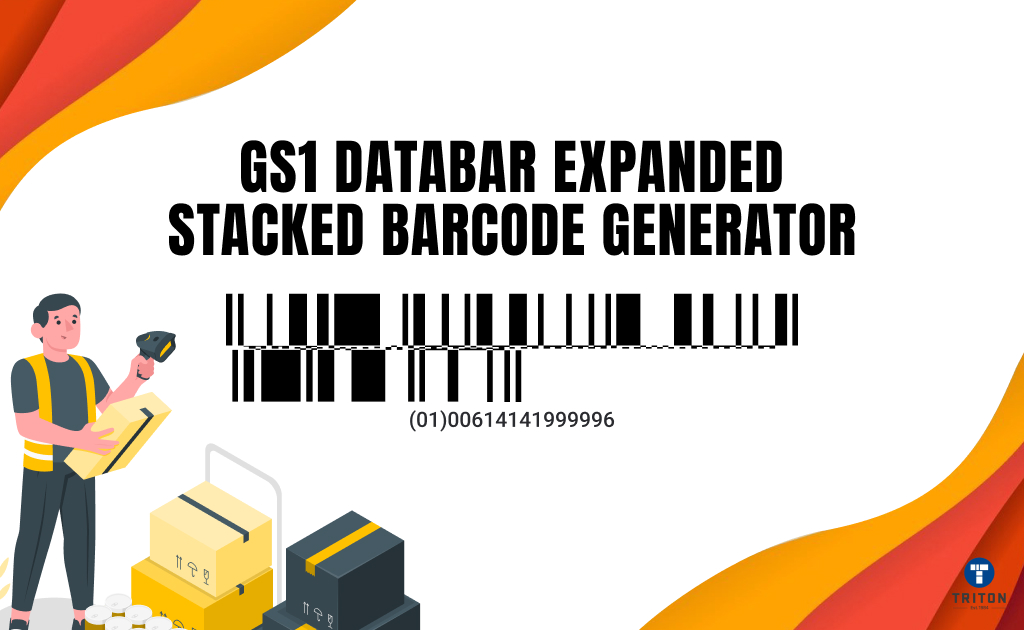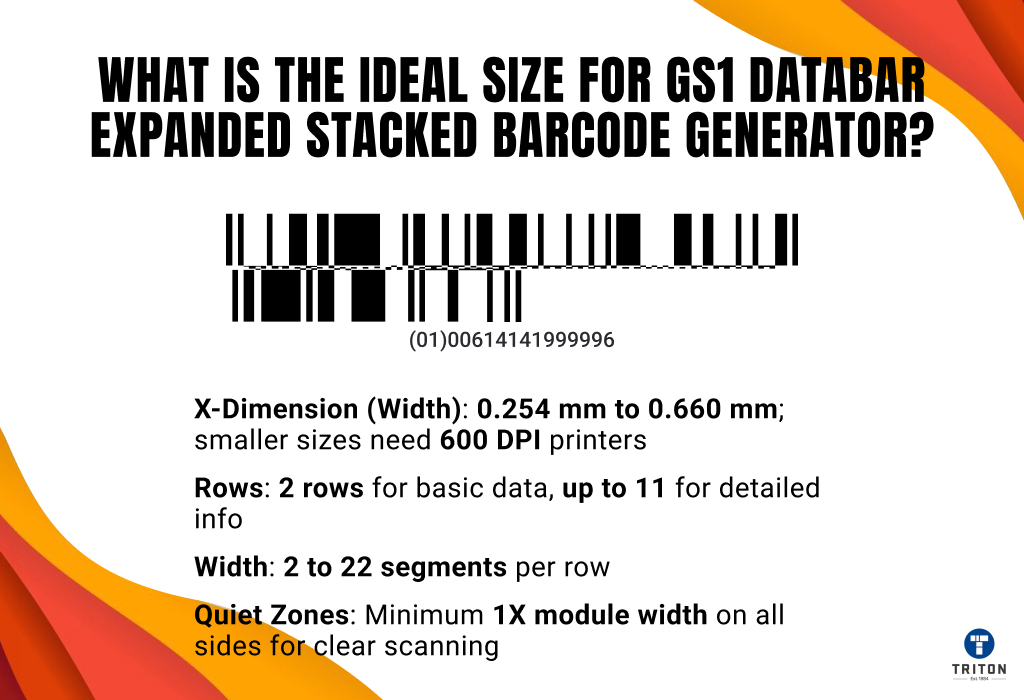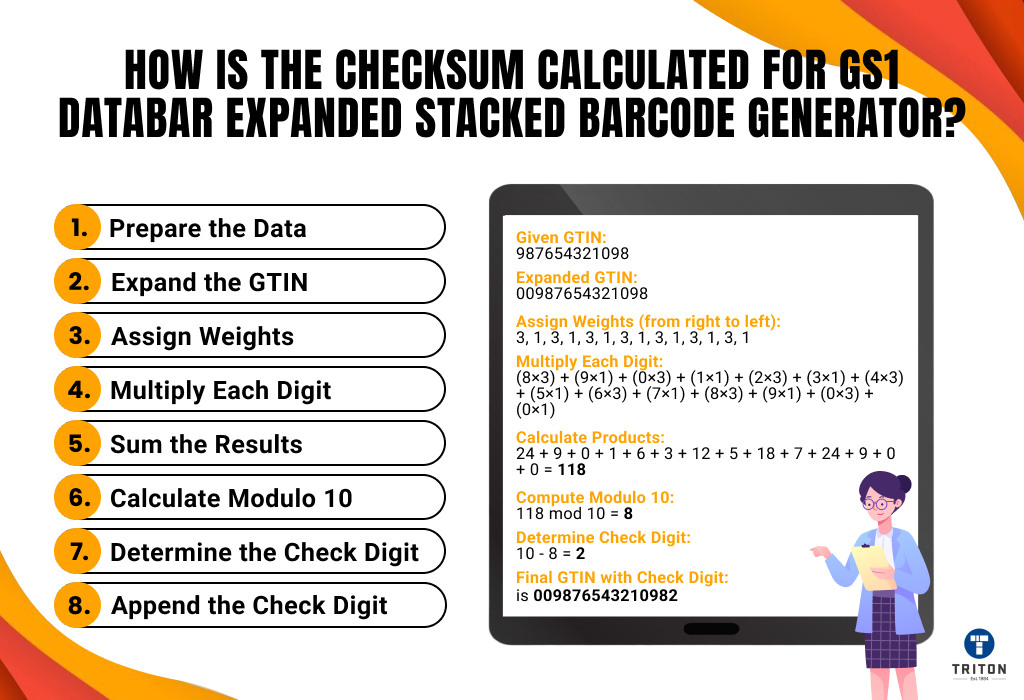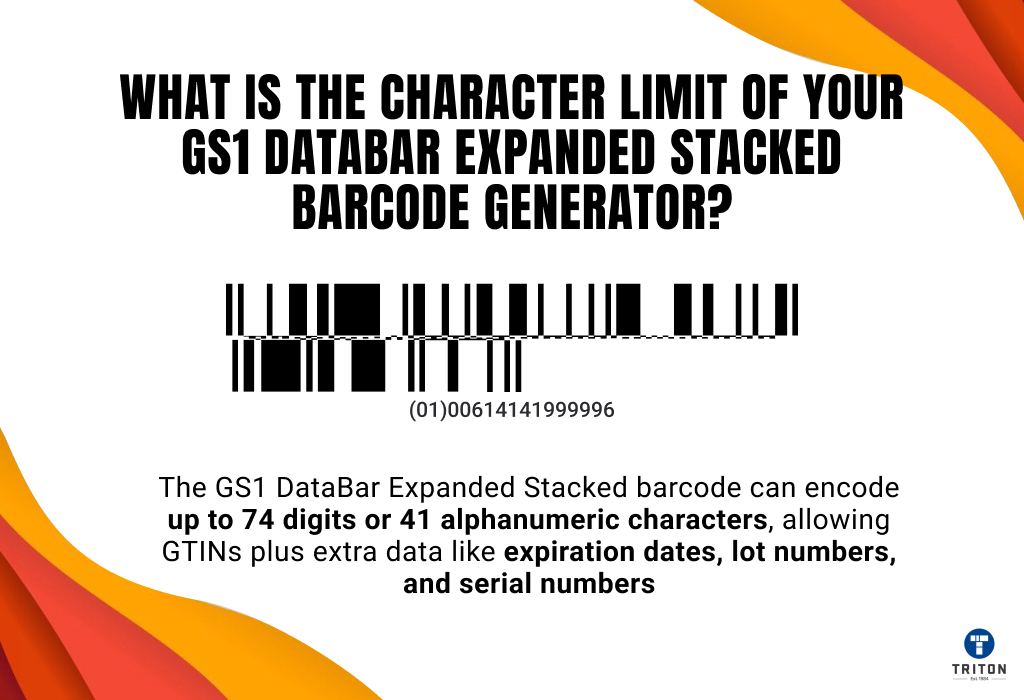
Our GS1 DataBar Expanded Stacked Barcode Generator allows you to create accurate barcodes for efficient product identification and inventory management. Compatible with PDF, PNG, SVG, and JPG formats, you can generate, customise, and download GS1 DataBar Expanded Stacked barcodes effortlessly, streamlining your supply chain operations with precision.
The GS1 DataBar Expanded Stacked barcode is a linear, stacked symbology within the GS1 DataBar family. It is designed to encode a Global Trade Item Number (GTIN) along with supplementary data such as expiration dates, lot numbers, and weights. This barcode type is particularly useful in retail environments and is suitable for point-of-sale applications when scanned with compatible equipment.
The GS1 DataBar family includes seven barcode types, four of which are used at retail point-of-sale (POS). The GS1 DataBar Expanded Stacked is one of these four, making it ideal for retail applications. This symbology is defined in ISO/IEC 24724 and the GS1 General Specifications.

The ideal size of a GS1 DataBar Expanded Stacked barcode depends on data volume, printing resolution, and scanning requirements.
Key Size Parameters:
X-Dimension (Module Width): The smallest bar or space, recommended between 0.254 mm (10 mil) and 0.660 mm (26 mil). Smaller dimensions require high-resolution printers (600 DPI or higher).
Rows:
2 rows for minimal data (e.g., GTIN + expiration date).
Up to 11 rows for more complex data (e.g., GTIN + batch/lot + serial number).
Width: The barcode width is determined by the number of segments per row, ranging from 2 to 22 segments. Each segment comprises a specific number of modules.
Quiet Zones: A minimum of 1X (module width) on all sides ensures clear scanning.
Example Dimensions:
0.254 mm (10 mil), 2 rows: Height ~10.6 mm, width ~27.7 mm for small labels.
0.330 mm (13 mil), 3 rows: Height ~15.9 mm, width ~27.7 mm for fresh produce.
0.508 mm (20 mil), 2 rows: Height ~10.6 mm, width ~27.7 mm for retail items.
Considerations:
Maintain consistent X-dimensions for reliable scanning.
Use high-resolution printers (≥300 DPI) to ensure clear printing.
Adjust size based on item type—smaller for jewellery, larger for warehouse logistics.

Using our free GS1 DataBar Expanded Stacked Barcode Generator is simple. Enter your data, such as a Global Trade Item Number (GTIN), expiration date, lot number, or other GS1-compliant details. Leading zeros will be added automatically to GTINs shorter than 14 digits to meet GS1 standards.
Click “Generate GS1 DataBar Expanded Stacked Barcode” to create your barcode, adhering to GS1 specifications. Download the barcode in various formats—SVG, PNG, PDF, or JPG—for easy integration into product labels or packaging. Our generator ensures high-quality barcodes compatible with retail and supply chain systems.

Checksum calculation for GS1 DataBar Expanded Stacked barcodes ensures data integrity and follows a modulo 10 algorithm. Here’s a step-by-step process:
Prepare the Data:
Enter the Global Trade Item Number (GTIN) and any additional Application Identifiers (AIs), such as expiration dates or lot numbers.
Expand the GTIN:
If the GTIN is less than 14 digits, add leading zeros to meet the 14-digit standard.
Assign Weights:
Starting from the right, assign alternating weights of 3 and 1 to each digit. For example, the rightmost digit gets a weight of 3, the next digit to the left gets a weight of 1, and so on.
Multiply Each Digit by Its Weight:
Multiply each digit by its corresponding weight.
Sum the Results:
Add the products of all the digits and weights together.
Calculate Modulo 10:
Divide the sum by 10 and find the remainder.
Determine the Check Digit:
Subtract the remainder from 10. If the remainder is 0, the check digit is also 0.
Append the Check Digit:
Add the check digit to the end of the data before encoding it into the barcode.
Let’s walk through an example to understand this better.
GTIN: 987654321098
Expanded GTIN: 00987654321098
Weights (from right to left): 3, 1, 3, 1, 3, 1, 3, 1, 3, 1, 3, 1, 3, 1
Step-by-Step Calculation:
Multiply each digit by its weight:
(8×3) + (9×1) + (0x3) + (1×1) + (2×3) + (3×1) + (4×3) + (5×1) + (6×3) + (7×1) + (8×3) + (9×1) + (0x3) + (0x1)
Calculate the products:
24 + 9 + 0 + 1 + 6 + 3 + 12 + 5 + 18 + 7 + 24 + 9 + 0 + 0
Sum the results:
24 + 9 + 0 + 1 + 6 + 3 + 12 + 5 + 18 + 7 + 24 + 9 + 0 + 0 = 118
Calculate Modulo 10:
118 mod 10 = 8
Determine the Check Digit:
10 – 8 = 2
Final Result:
The final GTIN with the check digit is 009876543210982.
This process ensures the barcode’s data is accurate and reliable for scanning across various systems.

The GS1 DataBar Expanded Stacked barcode can encode up to 74 numeric characters or 41 alphanumeric characters. This capacity allows for the inclusion of a GTIN along with additional data, such as expiration dates, lot numbers, and serial numbers, making it suitable for detailed product information.
There is no scan limit for the GS1 DataBar Expanded Stacked barcode generated using our online barcode generator. Once created, the barcode can be scanned unlimited times, provided it meets printing quality standards and maintains proper quiet zones. This ensures reliable performance across various scanning devices and environments, including retail point-of-sale systems and warehouse logistics.
Yes, we offer a wide range of barcode generators. Besides the GS1 DataBar Expanded Stacked generator, you can create barcodes such as QR Code, Code 128, Code 39, EAN-13, ITF, and Data Matrix. We also support specialised formats like Aztec code, Maxicode, and PDF 417. Each generator allows for customisation and download in commercial-use formats, catering to various business needs in retail, logistics, and inventory management.
Melbourne
Brisbane
Phone 1300 558 438
Live Chat – Widget below
Melbourne
Brisbane
Phone 1300 558 438
Live Chat – Widget below